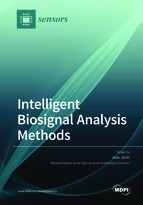Intelligent Biosignal Analysis Methods
A special issue of Sensors (ISSN 1424-8220). This special issue belongs to the section "Intelligent Sensors".
Deadline for manuscript submissions: closed (15 May 2021) | Viewed by 56774
Special Issue Editor
Special Issue Information
Dear colleagues,
At present, intelligent biosignal analysis methods are involved in a wide range of significant biomedical applications, ranging from clinical decision support systems and portable personal devices used for patient screening and monitoring to organism state and disorder modeling. The choice of use of biosignal analysis methods depends on the goal of the analysis, hardware and software availability, and potential real-time requirements. Biosignals are usually measured using electrodes attached to analysis-specific parts of the body, but they may also be acquired using other types of sensors. The analysis methods usually form a type of pipeline that starts with raw-measured biosignals and ends with an intelligent decision.
The focus of this Special Issue is on different types of methods used for intelligent analysis of biosignals. This includes preprocessing methods, feature extraction methods, feature selection methods, and data modeling methods. Data modeling methods involve traditional machine learning methods and more recent deep learning approaches. All of the analysis methods are continuously evolving and improving within the field of artificial intelligence, and their application to biosignals is highly significant for improving patients’ health and healthcare in general.
The applications of intelligent biosignal processing methods to electrocardiogram, electroencephalogram, electromyogram, skin-resistance, oxygen saturation, and other types of biosignals may be considered for publication in this Special Issue. Differences in application of processing methods to data from fixed, portable, wearable, and implementable sensors may also be considered.
Both original and review papers are welcome.
Prof. Dr. Alan Jović
Guest Editor
Manuscript Submission Information
Manuscripts should be submitted online at www.mdpi.com by registering and logging in to this website. Once you are registered, click here to go to the submission form. Manuscripts can be submitted until the deadline. All submissions that pass pre-check are peer-reviewed. Accepted papers will be published continuously in the journal (as soon as accepted) and will be listed together on the special issue website. Research articles, review articles as well as short communications are invited. For planned papers, a title and short abstract (about 100 words) can be sent to the Editorial Office for announcement on this website.
Submitted manuscripts should not have been published previously, nor be under consideration for publication elsewhere (except conference proceedings papers). All manuscripts are thoroughly refereed through a single-blind peer-review process. A guide for authors and other relevant information for submission of manuscripts is available on the Instructions for Authors page. Sensors is an international peer-reviewed open access semimonthly journal published by MDPI.
Please visit the Instructions for Authors page before submitting a manuscript. The Article Processing Charge (APC) for publication in this open access journal is 2600 CHF (Swiss Francs). Submitted papers should be well formatted and use good English. Authors may use MDPI's English editing service prior to publication or during author revisions.
Keywords
- Biosignal processing
- Modeling methods
- Time-series analysis
- Machine learning
- Deep learning
- Feature extraction
- Feature selection







